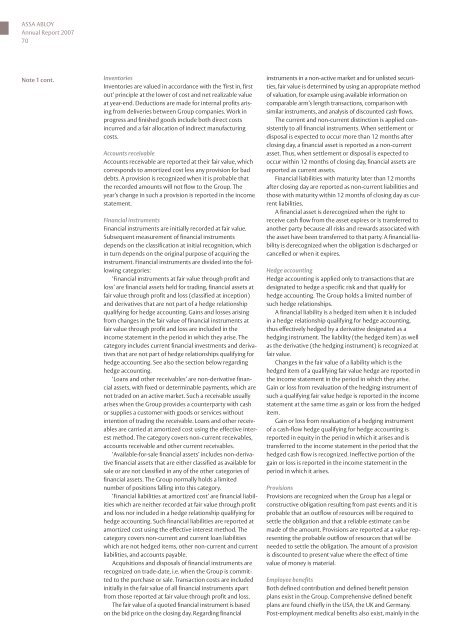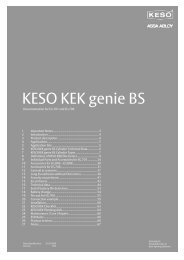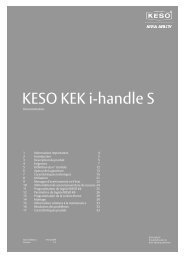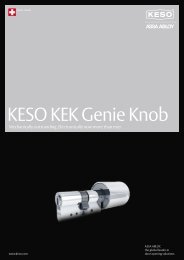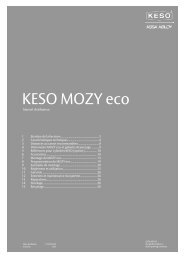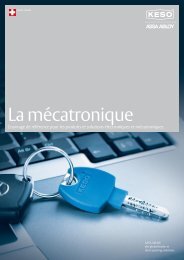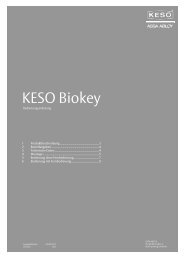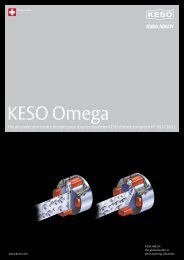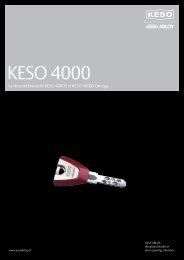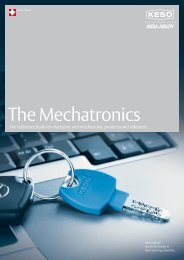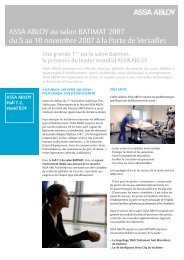You also want an ePaper? Increase the reach of your titles
YUMPU automatically turns print PDFs into web optimized ePapers that Google loves.
ASSA ABLOY<br />
Annual Report 2007<br />
70<br />
Note 1 cont.<br />
Inventories<br />
Inventories are valued in accordance with the ‘first in, first<br />
out’ principle at the lower of cost and net realizable value<br />
at year-end. Deductions are made for internal profits arising<br />
from deliveries between Group companies. Work in<br />
progress and finished goods include both direct costs<br />
incurred and a fair allocation of indirect manufacturing<br />
costs.<br />
Accounts receivable<br />
Accounts receivable are reported at their fair value, which<br />
corresponds to amortized cost less any provision for bad<br />
debts. A provision is recognized when it is probable that<br />
the recorded amounts will not flow to the Group. The<br />
year’s change in such a provision is reported in the income<br />
statement.<br />
Financial instruments<br />
Financial instruments are initially recorded at fair value.<br />
Subsequent measurement of financial instruments<br />
depends on the classification at initial recognition, which<br />
in turn depends on the original purpose of acquiring the<br />
instrument. Financial instruments are divided into the following<br />
categories:<br />
‘Financial instruments at fair value through profit and<br />
loss’ are financial assets held for trading, financial assets at<br />
fair value through profit and loss (classified at inception)<br />
and derivatives that are not part of a hedge relationship<br />
qualifying for hedge accounting. Gains and losses arising<br />
from changes in the fair value of financial instruments at<br />
fair value through profit and loss are included in the<br />
income statement in the period in which they arise. The<br />
category includes current financial investments and derivatives<br />
that are not part of hedge relationships qualifying for<br />
hedge accounting. See also the section below regarding<br />
hedge accounting.<br />
‘Loans and other receivables’ are non-derivative financial<br />
assets, with fixed or determinable payments, which are<br />
not traded on an active market. Such a receivable usually<br />
arises when the Group provides a counterparty with cash<br />
or supplies a customer with goods or services without<br />
intention of trading the receivable. Loans and other receivables<br />
are carried at amortized cost using the effective interest<br />
method. The category covers non-current receivables,<br />
accounts receivable and other current receivables.<br />
‘Available-for-sale financial assets’ includes non-derivative<br />
financial assets that are either classified as available for<br />
sale or are not classified in any of the other categories of<br />
financial assets. The Group normally holds a limited<br />
number of positions falling into this category.<br />
‘Financial liabilities at amortized cost’ are financial liabilities<br />
which are neither recorded at fair value through profit<br />
and loss nor included in a hedge relationship qualifying for<br />
hedge accounting. Such financial liabilities are reported at<br />
amortized cost using the effective interest method. The<br />
category covers non-current and current loan liabilities<br />
which are not hedged items, other non-current and current<br />
liabilities, and accounts payable.<br />
Acquisitions and disposals of financial instruments are<br />
recognized on trade-date, i.e. when the Group is committed<br />
to the purchase or sale. Transaction costs are included<br />
initially in the fair value of all financial instruments apart<br />
from those reported at fair value through profit and loss.<br />
The fair value of a quoted financial instrument is based<br />
on the bid price on the closing day. Regarding financial<br />
instruments in a non-active market and for unlisted securities,<br />
fair value is determined by using an appropriate method<br />
of valuation, for example using available information on<br />
comparable arm’s length transactions, comparison with<br />
similar instruments, and analysis of discounted cash flows.<br />
The current and non-current distinction is applied consistently<br />
to all financial instruments. When settlement or<br />
disposal is expected to occur more than 12 months after<br />
closing day, a financial asset is reported as a non-current<br />
asset. Thus, when settlement or disposal is expected to<br />
occur within 12 months of closing day, financial assets are<br />
reported as current assets.<br />
Financial liabilities with maturity later than 12 months<br />
after closing day are reported as non-current liabilities and<br />
those with maturity within 12 months of closing day as current<br />
liabilities.<br />
A financial asset is derecognized when the right to<br />
receive cash flow from the asset expires or is transferred to<br />
another party because all risks and rewards associated with<br />
the asset have been transferred to that party. A financial liability<br />
is derecognized when the obligation is discharged or<br />
cancelled or when it expires.<br />
Hedge accounting<br />
Hedge accounting is applied only to transactions that are<br />
designated to hedge a specific risk and that qualify for<br />
hedge accounting. The Group holds a limited number of<br />
such hedge relationships.<br />
A financial liability is a hedged item when it is included<br />
in a hedge relationship qualifying for hedge accounting,<br />
thus effectively hedged by a derivative designated as a<br />
hedging instrument. The liability (the hedged item) as well<br />
as the derivative (the hedging instrument) is recognized at<br />
fair value.<br />
Changes in the fair value of a liability which is the<br />
hedged item of a qualifying fair value hedge are reported in<br />
the income statement in the period in which they arise.<br />
Gain or loss from revaluation of the hedging instrument of<br />
such a qualifying fair value hedge is reported in the income<br />
statement at the same time as gain or loss from the hedged<br />
item.<br />
Gain or loss from revaluation of a hedging instrument<br />
of a cash-flow hedge qualifying for hedge accounting is<br />
reported in equity in the period in which it arises and is<br />
transferred to the income statement in the period that the<br />
hedged cash flow is recognized. Ineffective portion of the<br />
gain or loss is reported in the income statement in the<br />
period in which it arises.<br />
Provisions<br />
Provisions are recognized when the Group has a legal or<br />
constructive obligation resulting from past events and it is<br />
probable that an outflow of resources will be required to<br />
settle the obligation and that a reliable estimate can be<br />
made of the amount. Provisions are reported at a value representing<br />
the probable outflow of resources that will be<br />
needed to settle the obligation. The amount of a provision<br />
is discounted to present value where the effect of time<br />
value of money is material.<br />
Employee benefits<br />
Both defined contribution and defined benefit pension<br />
plans exist in the Group. Comprehensive defined benefit<br />
plans are found chiefly in the USA, the UK and Germany.<br />
Post-employment medical benefits also exist, mainly in the


